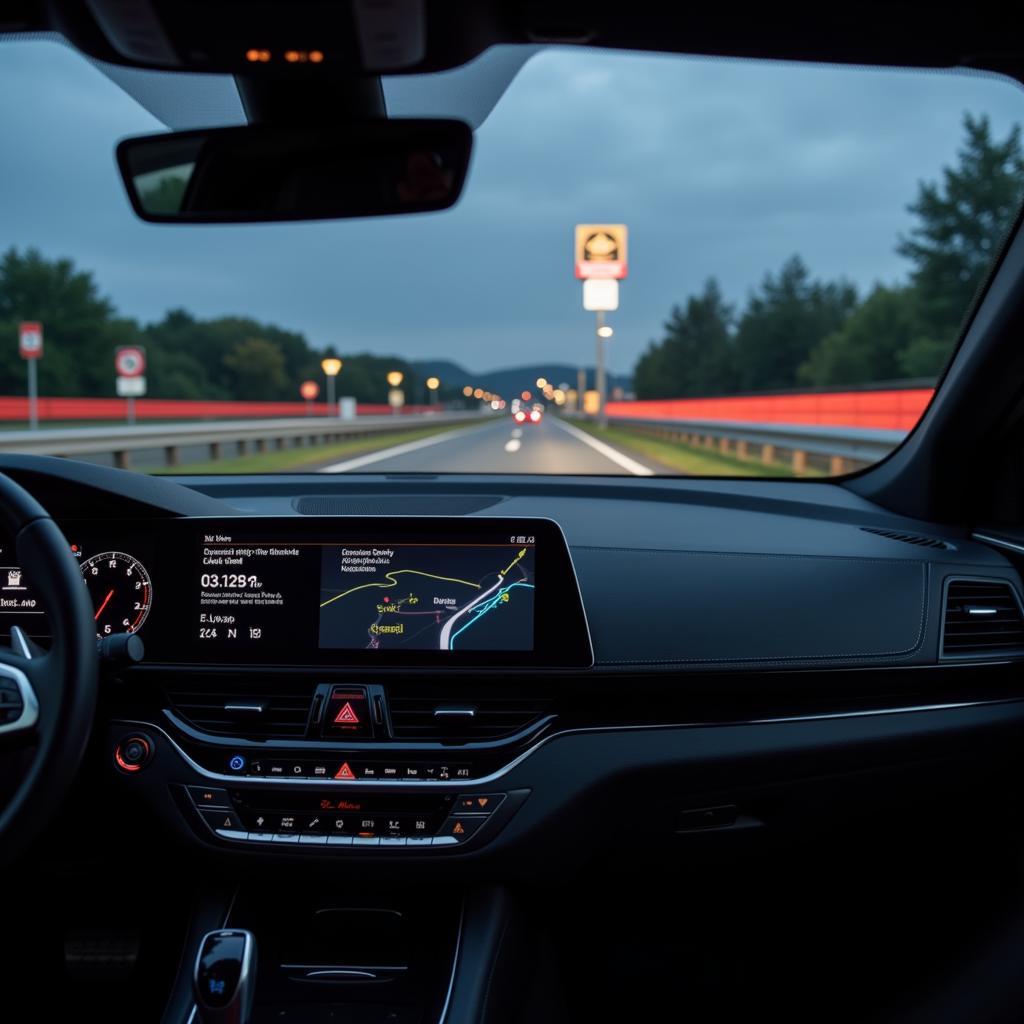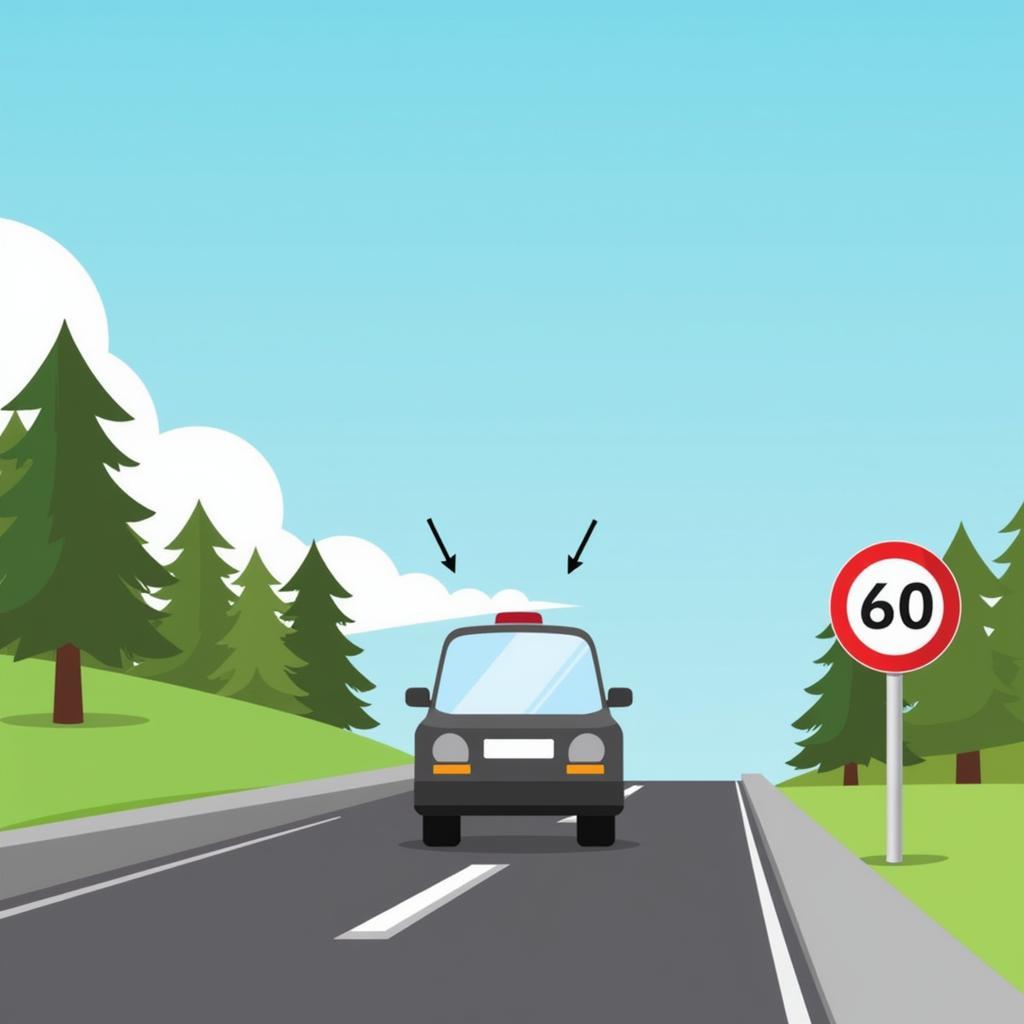The active driving display with traffic sign recognition 25 is a cutting-edge safety feature found in many modern vehicles. This advanced system utilizes a forward-facing camera, typically mounted near the rearview mirror, to detect and display road signs directly in the driver’s line of sight. This article delves into the intricacies of this technology, covering its functionalities, benefits, potential issues, and troubleshooting tips.
Understanding Active Driving Display and Traffic Sign Recognition
The active driving display acts as a digital extension of your dashboard, projecting essential information onto a screen strategically positioned within the driver’s primary field of vision. This information can include speed limit warnings, navigation prompts, and even alerts from your vehicle’s safety systems. When coupled with traffic sign recognition, the system gains the ability to identify and display road signs, such as speed limits, stop signs, and no-passing zones.
Traffic sign recognition 25, as the name implies, represents a specific iteration or generation of this technology. This could indicate a software version, hardware revision, or a combination of both, potentially offering enhanced accuracy, a broader recognition range, or compatibility with a wider array of traffic signs compared to its predecessors.
Benefits of Utilizing an Active Driving Display with Traffic Sign Recognition 25
The advantages of having an active driving display with traffic sign recognition 25 extend beyond mere convenience. This system contributes significantly to road safety by:
- Enhancing Situational Awareness: By keeping crucial information within the driver’s direct line of sight, the system minimizes the need to glance away from the road, promoting better awareness of the surrounding environment.
- Preventing Speeding Violations: Real-time display of speed limits serves as a constant reminder, helping drivers stay within legal limits and avoid potential fines.
- Aiding Navigation: Navigation prompts projected directly onto the windshield reduce the need to look down at a separate GPS device or the car’s infotainment screen, ensuring safer and more efficient navigation.
- Improving Reaction Time: Early warnings about upcoming stop signs, sharp curves, or other potential hazards allow drivers to react proactively, potentially mitigating accidents.
 Modern car dashboard with active driving display
Modern car dashboard with active driving display
Common Issues and Troubleshooting
While the active driving display with traffic sign recognition 25 is a robust system, it’s not entirely immune to issues. Here are some common problems and potential solutions:
- Inaccurate or Missing Sign Recognition: Environmental factors like glare, poor weather conditions, or obstructed signs can hinder the camera’s ability to accurately identify signs. Ensure the windshield is clean and the camera lens is unobstructed.
- System Malfunctions or Errors: Software glitches or sensor errors can disrupt the system’s functionality. A simple system reset, achieved by restarting the car, often resolves temporary glitches.
- Calibration Issues: If the system consistently misinterprets signs or displays inaccurate information, camera recalibration might be necessary. Refer to your vehicle’s owner’s manual for instructions or consult a qualified technician.
“It’s crucial to remember,” advises automotive electronics specialist John Miller, “that even the most sophisticated driver-assistance systems are not substitutes for attentive driving. Always prioritize safe driving practices and remain vigilant behind the wheel.”
Maintaining Your Active Driving Display System
To ensure optimal performance and longevity of your active driving display with traffic sign recognition 25, consider these maintenance tips:
- Regularly Clean the Camera Lens: Use a soft, microfiber cloth to gently wipe away dust, dirt, or debris from the camera lens.
- Schedule Software Updates: Manufacturers often release software updates to enhance system performance, add new features, or fix known bugs. Check for updates periodically and install them as needed.
- Professional Inspection: If you encounter persistent issues or suspect a hardware malfunction, it’s advisable to seek professional diagnosis and repair from a qualified automotive technician.
 Car camera detecting traffic signs
Car camera detecting traffic signs
The Future of Active Driving Displays
The evolution of active driving displays is intrinsically linked to advancements in automotive technology. As vehicles become increasingly connected and autonomous, we can anticipate these displays to integrate seamlessly with other advanced driver-assistance systems (ADAS), providing a more comprehensive and intuitive driving experience. Augmented reality overlays, personalized information displays, and enhanced communication with smart infrastructure are just a glimpse into the exciting possibilities that lie ahead.
Conclusion
The active driving display with traffic sign recognition 25 represents a significant stride towards safer and more informed driving. By understanding its functions, benefits, and potential issues, drivers can maximize the utility of this advanced safety feature. Remember, while these systems offer valuable assistance, responsible driving habits remain paramount for ensuring safety on the road.
Frequently Asked Questions
1. Is the traffic sign recognition system compatible with all road signs?
While the system is designed to recognize a wide range of standard road signs, it might not be compatible with all variations or regional differences. Always refer to your vehicle’s owner’s manual for specific details regarding the system’s capabilities and limitations.
2. Can I adjust the brightness or position of the active driving display?
Most vehicles allow drivers to adjust the display’s brightness, contrast, and sometimes even its vertical position to suit individual preferences and lighting conditions. Consult your vehicle’s infotainment system settings for customization options.
3. Will the system still function correctly if I apply a tinted film to my windshield?
Applying aftermarket tints, especially those with metallic components, can interfere with the camera’s operation and hinder the system’s performance. Consult with a professional tint installer about tints compatible with your vehicle’s safety systems.
4. Does the system require an internet connection to function?
While internet connectivity might enhance certain features, such as real-time traffic updates, the core functionalities of the active driving display and traffic sign recognition system do not rely on an internet connection.
5. Can I retrofit my older vehicle with an active driving display and traffic sign recognition system?
Retrofitting older vehicles with such advanced safety systems is generally not feasible due to the complexity of integration with existing vehicle electronics and the potential need for additional hardware components.

